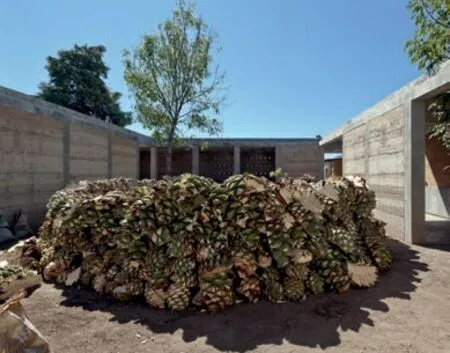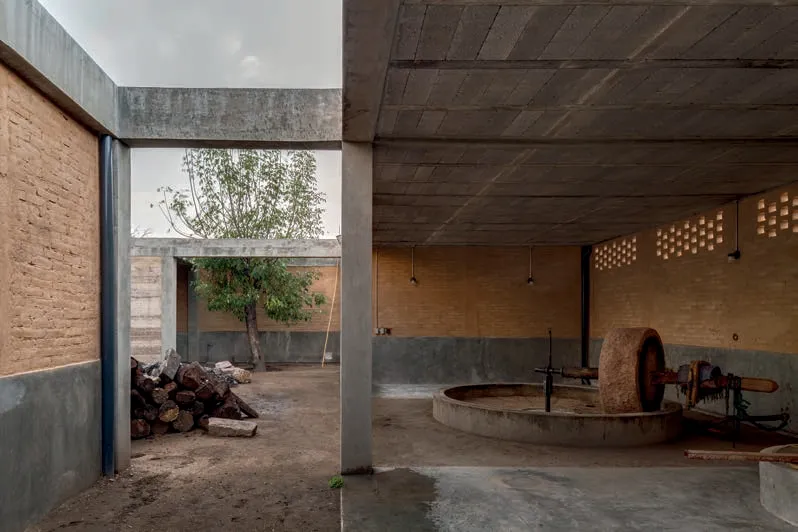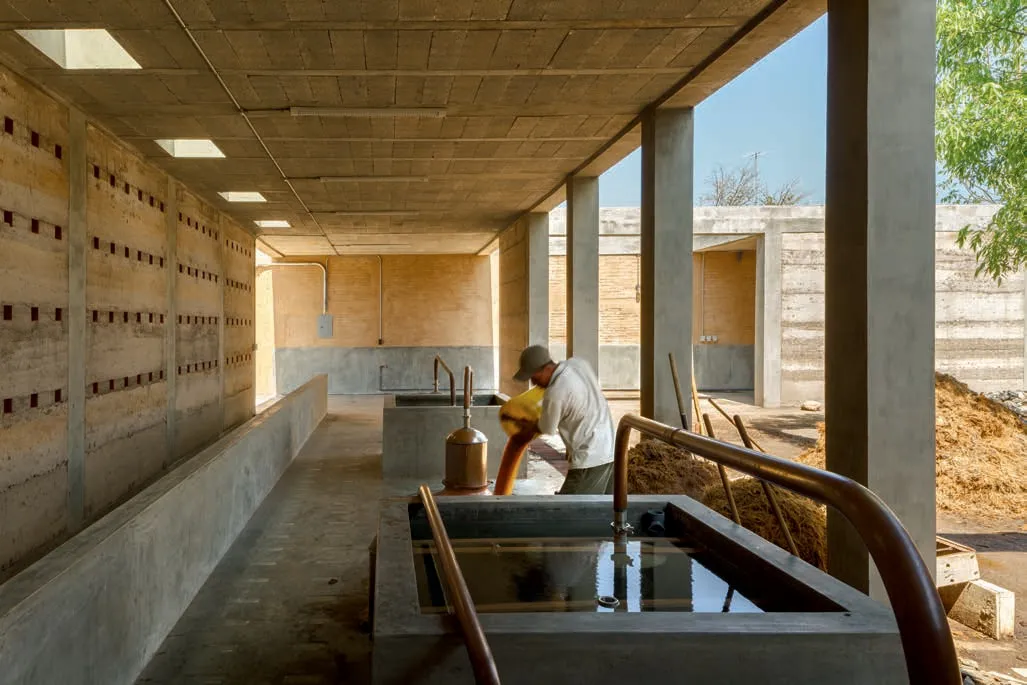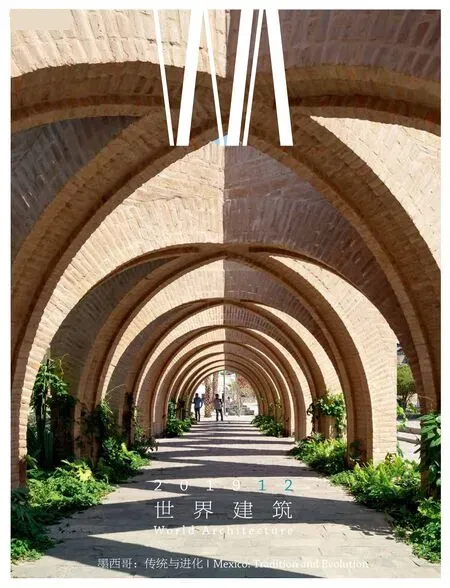米拉格里托梅斯卡尔酒酿酒坊,圣地亚哥德马塔特兰,瓦哈卡,墨西哥
2019-12-24建筑设计安布罗西埃切加雷事务所
建筑设计:安布罗西-埃切加雷事务所

1 鸟瞰/Aerial view
遗产:(1)将某物传给后人的行为。(2)留给或传给后代的东西。
梅斯卡尔酒:源自纳瓦特尔语“mexcalli”(烹制的龙舌兰叶),由“metl”(龙舌兰)和“ixcalli”(烤制)组成。传统墨西哥酒精饮料,由龙舌兰属植物蒸馏酿成。
酒坊:与梅斯卡尔酒酿造有关的物理空间
梅斯卡尔酒的酿造在瓦哈卡是一个具有重要意义的传统。市场和产品需求的增长使得当地酿酒商不得不为维持手工酿酒法努力。大量关于梅斯卡尔酒的用途、知识和习俗流传至今,并在日常生活和仪式中会经常用到。
阿瓦德一家酿造梅斯卡尔酒已历经三代。吉列尔莫·阿瓦德用的是他父亲和祖父传下来的知识,同时也在融合现代化的视野,以维持不断增长的市场所需的产量。为了让家族仪式与传统汇聚一堂,翻新核心空间就成为了一个新的需求。
最小的儿子在婚后继承的家宅被称为“大房子”。这也是他父母和祖父母三世同堂的房子,而维系这个家族的就是酿造梅斯卡尔酒的家族产业。每种酒的背后都有一位酿酒大师,负责在酿酒过程中延续继承下来的传统和直觉。阿瓦德一家都住在“大房子”里,而维系了他们70 年生计的酿酒作坊就在房子后面。

2 龙舌兰属植物/Agave plants
委托项目的核心是翻新酿酒空间,满足出口的标准,并维持传统的场所、家庭和手工生产。
项目从组织酿酒的各个阶段开始,让生产过程围绕世代相传的土灶展开。这个空间被一系列就地取材、压实的土墙包围。中心区是项目的核心,也是酿酒不同阶段的分流点。通过这种方式,项目延续了从这种美酒、从大地,以及从酿造梅斯卡尔酒数十年的传统家族中传承下来的仪式。有几个空间是专门为酿造梅斯卡尔酒的特定功能设计的。房子后部是酒坊的主要加工区和检查酿酒酵母和种子的试验室。临街的前部是装瓶区。最后,在房子中心天井处设计了一个品酒厅。所有的建筑都由混凝土板、压实土墙、混凝土结构框架和一些钢构件建成。
酒坊
项目第一阶段造价为160 万墨西哥比索。项目的第一阶段由墨西哥政府的农牧业农村发展渔业和食品部(SAGARPA)的小生产商补助提供资金。这项激励措施为生产者提供了50%的联合投资。
施工共持续了30 个月,期间多家当地承建商进行了工程管理。整个过程由于管理问题曾中断6个月。
为项目添彩的是,承建商提供了各种本地技术,比如预制混凝土水箱和混有石灰的压实土墙。不过,项目在施工中还存在不足,比如钢筋混凝土体系、预制托梁和筒拱天花,以及一般安装误差。□(尚晋 译)

3 总平面/Site plan

4 实景/View of the Palenque
项目信息/Credits and Data
地点/Location: Santiago de Matatlán, Oaxaca, Mexico
客户/Client: Mezcales Milagrito
主持建筑师/Principal Architects: Jorge Ambrosi, Gabriela Etchegaray
设计团队/Design Team: Gerardo Reyes
材料及结构/Material and Structure: 混凝土及夯土墙/Concrete and rammed-earth walls
建筑面积/Floor Area: 360m2
造价/Cost: 3,000,000 MXN(约1,079,000 CNY)
设计及建造时间/Design-Built Time: 2012-2016
摄影/Photos: Onnis Luque (fig.1,2,9), Rafael Gamo (fig.4-6,8,10-12)

5 实景/View of the Palenque

6 墙体局部/Wall detailed view
Legacy:
1. The action of transmitting something down to other people.
2. Something that is left or transferred across generations.
Mezcal:
1. (From náhuatl mexcalli, "cooked leaves of maguey", from metl "maguey" and ixcalli "baked")
Traditional Mexican alcoholic beverage elaborated from the distillation of the agave plants.
Palenque:
1. Physical space where activities related to the production of Mezcal take place.
Mezcal production is a tradition of great importance in Oaxaca. The expansion of the market and demand for the product has created a struggle among local producers to maintain an artisanal method of production. There exists an extensive legacy of uses, knowledge, and customs surrounding mezcal that are used daily at social and ritualistic levels.
The Abad family has produced mezcal for three generations. Guillermo Abad uses the knowledge inherited from his father and grandfather while also integrating visions of modernization to maintain a level of production demanded from the growing market. Through this arose the necessity to renovate the spatial core where the familial rituals and traditions converge.
The family home that was inherited by the youngest son after his marriage is named the "Casa Grande" (Big House). This is the same house were his parents and grandparents lived throughout the rest of their lives in a multi-generational community sustained through the family business of making mezcal.Behind each product there is a master mezcalero, who is responsible for maintaining the continuity of production in line with the traditions and intuitions acquired.The Abad family lives in the "Casa Grande", and the production that has maintained them for over 70 years rests at the back of the property.
The commission centered on renovating the production spaces in such a way that the exportation standards could be met while maintaining the traditional place, family, and artisanal production.
The project began with organizing the distinct stages of production around the earth oven that has located in the same place throughout the multiple generations.This space is contained by a series of compressed earth walls made from the dirt excavated at the site.This central area functions as the heart of the project and the point of distribution for the different phases of production. In this way the Project embodies the ritual inherited from the drink, from the earth, and from the traditional families that have produced Mezcal throughout the decades. There are several spaces geared toward specific functions involved in the production of mezcal.At the rear the main operational area of the Palenque and a laboratory for conducting investigations on brewer's yeast and seeds. At the front, against the street, is the bottling area. Finally,a tasting pavilion has been proposed in the central patio of the house. All the structures are made up of concrete slabs, compressed earth walls, concrete structural frames, and some steel elements.
The Palenque
The total cost of the first phase was 1.6 millon MXN. The first phase of the project was financed through a government grant from SAGARPA for small producers. The incentive offered a plan of coinvestment of 50% with the producer.
The construction lasted a total of 30 months,during which various local contractors managed the job.The process was stopped for a duration lasting 6 months due to administrative problems.
Enrichment of the project came when contractors offered local technologies such as precast concrete cisterns, and compressed earth walls mixed with lime. Still the project suffered shortcomings in construction such as with the reinforced concrete system, the precast joist and vault ceilings, and general installations errors.□

7 首层平面/Ground floor plan

8 实景/View of the Palenque

9 生产过程/Production process
评论
戴维·巴苏尔托:梅斯卡尔酒在世界上广为人知,它由野生的龙舌兰制成,其生产设施通常规模较小,分散在各地,并始终坚持采用传统技术。米拉格里托梅斯卡尔酒酿酒坊保留了梅斯卡尔手工酿造的环境条件,并在其建造过程中,通过对混凝土及酿造龙舌兰多年的土灶的泥土的混合使用,体现它的精神。最终这里呈现出的是一座高质量的现代设施,忠实体现梅斯卡尔手工酿造的工艺,不仅在其墙体上以象征的方式反映梅斯卡尔酒的本质,更重要的是,通过对气味的塑造,激活人们对它的感性认识。(庞凌波 译)
路璐:合院的居住类型平面容纳了一套作坊式的酿酒制作流程,墙体与柱列没有明确区分室内和室外空间。朴素且克制的结构形式,以及传统材料筑成的墙体,让这座建筑超越了时代潮流。这里看不到墨西哥建筑师曾经的激情,却能感受到他们当下的冷静。热带气候下的墨西哥现代建筑,在各个层面打破了室内和室外的界限(与封闭的盒子相对),曾为20世纪的现代主义建筑做出巨大贡献,而反过来,我们也可以用这一特征去反观当下的墨西哥建筑,从而对其身份进行辨识。

10 生产过程/Production process


11.12 实景/Views of the Palenque

13 剖面/Section
Comments
David Basulto: The Mezcal spirit, which is becoming widely known across the world, comes from the wild agave, with the production facilities often being of small scale, scattered throughout the territory and still using traditional techniques.The Milagritos Mezcal Pavilion stays true to the artisanal condition of mezcal and embodies its spirit in its construction,by using a mix of concrete and earth coming from the excavated earth ovens where the agave has been cooked for years. The result is a modern facility with high standards that stays true to the artisanal production of mezcal, embodying the essence of the spirit in its walls not just in a symbolic way, but also through the smell that it projects, activating the senses.
LU Lu: The courtyard contains a wine-making workshop, and the wall and pillar lines did not clearly divide the space into indoor and outdoor. The plain and restrained structural form and the wall made of traditional materials bring the construction beyond its time. The passion of Mexican architects cannot be seen here, replaced by their restraint at the time. The modern Mexican architecture in the tropical climate breaks the border between interior and exterior space at every level (compared with closed boxes). It has made significant contribution to modern architecture in the 20th century,and reversely, now we can use this feature to observe the Mexican architecture at present so as to recognise their identity. (Translated by QIAN Fang)
